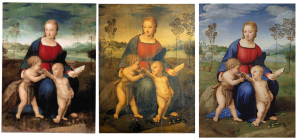 All’inizio del mese di giugno, avevamo scritto di un quadro raffigurante la “Madonna del Cardellino”, opera conosciutissima di Raffaello Sanzio, databile al 1506 circa e conservata nella Galleria degli Uffizi a Firenze, che, secondo alcune indicazioni, sarebbe custodita nella cassaforte di una banca svizzera, in attesa di trovare un acquirente.
All’inizio del mese di giugno, avevamo scritto di un quadro raffigurante la “Madonna del Cardellino”, opera conosciutissima di Raffaello Sanzio, databile al 1506 circa e conservata nella Galleria degli Uffizi a Firenze, che, secondo alcune indicazioni, sarebbe custodita nella cassaforte di una banca svizzera, in attesa di trovare un acquirente.
Del dipinto, avevamo anche pubblicato un’immagine comparandola con la “Madonna del Cardellino”. Poi, per 22 giorni, non avevamo più avuto notizie della preziosa opera.
Ieri, 24 giugno 2012, il commento al nostro primo articolo da parte di una lettrice (o lettore) che si firma con il nome di “ciara22”, ci riporta a parlare di quest’opera.
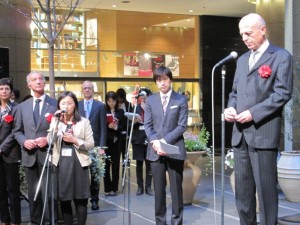 Secondo “ciara22”, il dipinto in questione sarebbe la “Madonna di Vallombrosa”, seconda versione di Raffaello della Madonna del Cardellino, che, per la prima volta dall’inizio del 1800, è stato esposto al pubblico presso la fiera di successo Da Vinci nel Museo Bunkamura of Art, Tokyo in Giappone (Febbraio-Giugno 2012).
Secondo “ciara22”, il dipinto in questione sarebbe la “Madonna di Vallombrosa”, seconda versione di Raffaello della Madonna del Cardellino, che, per la prima volta dall’inizio del 1800, è stato esposto al pubblico presso la fiera di successo Da Vinci nel Museo Bunkamura of Art, Tokyo in Giappone (Febbraio-Giugno 2012).
Siamo così venuti in possesso di alcune immagini e di una presentazione dell’opera esposta a Tokyo, che, almeno apparentemente, sembrano identiche a quell’unica foto che era in nostro possesso e che avevamo inserito nell’articolo del 2 Giugno.
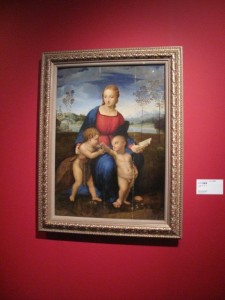 La “Madonna di Vallombrosa”, era stata ordinata e pagata dai due fratelli Giovanni Battista e Domenico di Francesco del Milanese, come pala d’altare per il Monastero di Vallombrosa (fuori Firenze) nel 1506. E lì rimase fino a quando le truppe napoleoniche non invasero Firenze nel 1808 e l’opera venne acquistata dal generale francese Laforest.
La “Madonna di Vallombrosa”, era stata ordinata e pagata dai due fratelli Giovanni Battista e Domenico di Francesco del Milanese, come pala d’altare per il Monastero di Vallombrosa (fuori Firenze) nel 1506. E lì rimase fino a quando le truppe napoleoniche non invasero Firenze nel 1808 e l’opera venne acquistata dal generale francese Laforest.
Restaurata nel 1835 a Firenze dal famoso restauratore Giovanni Colzi de Cavalcante, sembra sia finita a far parte del ricco bottino di guerra che i soldati tedeschi portarono via dall’Italia nel corso della loro ritirata.
Il documento che sotto vi proponiamo in inglese, utilizzato per la mostra tenuta in Giappone, sembrerebbe avvalorare la tesi che si tratti proprio della “Madonna di Vallombrosa”, realizzata (o alla cui realizzazione prese parte) da Raffaello.
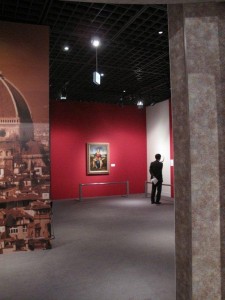 Ad avvalorare la tesi che si tratti della “Madonna di Vallombrosa”, e che la stessa vide la partecipazione di Raffaello Sanzio, gli studiosi che hanno avuto modo di analizzare questo capolavoro e le indagini strumentali condotte dai laboratori della Lumier a Parigi, che hanno utilizzato le più moderne attrezzature tecniche con una combinazione di IR / X-ray chiamato Multispectral. Un metodo già utilizzato per analizzare altri capolavori di certa attribuzione, che permette di vedere i disegni sottostanti la pittura.
Ad avvalorare la tesi che si tratti della “Madonna di Vallombrosa”, e che la stessa vide la partecipazione di Raffaello Sanzio, gli studiosi che hanno avuto modo di analizzare questo capolavoro e le indagini strumentali condotte dai laboratori della Lumier a Parigi, che hanno utilizzato le più moderne attrezzature tecniche con una combinazione di IR / X-ray chiamato Multispectral. Un metodo già utilizzato per analizzare altri capolavori di certa attribuzione, che permette di vedere i disegni sottostanti la pittura.
Una storia che – come avevamo già scritto – ricorda quella di un’altra opera di Raffaello, la “Madonna Sistina”, commissionata nel 1512 come pala d’altare per la cappella del monastero di San Sisto nella città di Piacenza, fino a quando nel 1754, Augusto III di Polonia, grazie all’intervento del Papa – che approvò la cessione – la Madonna arrivò a Dresda. L’acquisto avvenne per quella che era allora una cifra enorme: 25.000 scudi.
Durante la seconda guerra mondiale, i nazisti spostarono la Madonna Sistina insieme a molti altri capolavori del mondo dell’arte in un nascondiglio nei pressi di Dresda. Il recupero della Madonna Sistina, avvenne grazie ad un ufficiale dell’esercito sovietico, Leonid Volynsky, che dopo un’accurata ricerca riuscì a scoprire il luogo dove erano stati nascosti i capolavori d’arte portati via dalla Galleria di Dresda. 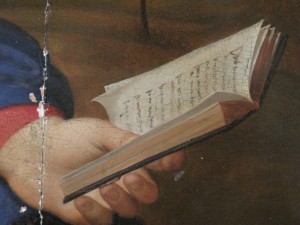 Fu così che in una cava abbandonata, ben nascosti, vennero rinvenuti oltre 1240 dipinti, tra i quali la “Madonna Sistina”, attualmente conservata a Dresda. La storia della ricerca e il recupero delle opere d’arte, viene descritta in dettaglio nel libro di Leonid Volynsky di “Seven Days”. Poche persone sapevano che Volynsky in realtà non era un cognome, ma lo pseudonimo del pittore e storico dell’arte Leonid Rabinovich.
Fu così che in una cava abbandonata, ben nascosti, vennero rinvenuti oltre 1240 dipinti, tra i quali la “Madonna Sistina”, attualmente conservata a Dresda. La storia della ricerca e il recupero delle opere d’arte, viene descritta in dettaglio nel libro di Leonid Volynsky di “Seven Days”. Poche persone sapevano che Volynsky in realtà non era un cognome, ma lo pseudonimo del pittore e storico dell’arte Leonid Rabinovich.
Un vero peccato che in Italia nessun Leonid Rabinovich, o Leonid Volynsky che dir si voglia, s’interessò di recuperare le tante opere d’arte trafugate dai tedeschi. Tant’è che, come specificato nel progetto presentato a Tokyo, esperti giuridici chiamati a valutare il legale possesso del dipinto, ritengono si tratti di uno dei 12.000 (sugli oltre 30.000) dipinti che, scomparsi durante la seconda guerra mondiale, non potrebbero più essere restituiti.
Secondo le ricerche effettuate infatti, del dipinto non c’è traccia in alcun archivio, né mai è stato reclamato da nessun proprietario.
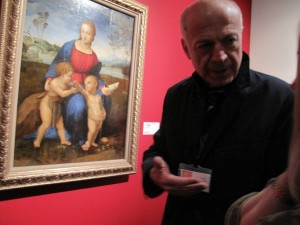 Inoltre – sostengono gli esperti – oggi l’opera non potrebbe essere più oggetto di alcun reclamo, visto che i termini per richiedere la riconsegna di beni trafugati nel corso della seconda guerra mondiale, sarebbero scaduti nel 1976.
Inoltre – sostengono gli esperti – oggi l’opera non potrebbe essere più oggetto di alcun reclamo, visto che i termini per richiedere la riconsegna di beni trafugati nel corso della seconda guerra mondiale, sarebbero scaduti nel 1976.
Che si tratti o meno della “Madonna di Vallombrosa”, ai fini del legittimo possesso, sembra dunque che conti poco. Gli unici dubbi che restano sono: l’opera esposta a Tokyo, è la stessa che pare si stia tentando di vendere in Svizzera (che a giudicare dalla foto pare proprio di sì…)?
E perché tante accortezze e silenzi, se possesso e vendita sono leciti e legittimi?
Questi i documenti con i quali il presunto capolavoro di Raffaello Sanzio è stato presentato alla mostra di Tokyo:
-Summary – Project “Madonna di Vallombrosa”
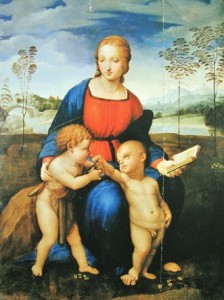 The tremendous demands for absolutely scientific proof which has developed during the last 30 years, together with scepticism and prestige, makes 100 % full proofs impossible to get – especially when talking about the real masterpieces from the top Renaissance painters as Da Vinci, Michelangelo or Raphael. Here to mention the constant going on discussions of for example Da Vinci´s Mona-Lisa in the Louvre or Lady with ermine in the museum of Krakow.
The tremendous demands for absolutely scientific proof which has developed during the last 30 years, together with scepticism and prestige, makes 100 % full proofs impossible to get – especially when talking about the real masterpieces from the top Renaissance painters as Da Vinci, Michelangelo or Raphael. Here to mention the constant going on discussions of for example Da Vinci´s Mona-Lisa in the Louvre or Lady with ermine in the museum of Krakow.
The professional science of art will not bind them-selves to a written report either in positive or negative direction – in our case a masterpiece by Raphael Santi da Urbino. The fundamental is that such report or certification must include possibilities to revise. The explanation possible is – that the established scientists who gives such a judgement are risking their whole career and reputation.
Already to indicate a positive attitude that Raphael has participated in the current painting puts very high demands of the scientists independence and integrity. Above all the quality of the painting itself must evidently be extremely high. The quality must be in a superb masterpiece quality, so that from this aspect there can be no doubts about the originator of the painting.
To get as close as possible for 100 % proof in all parts, we who are working with Madonna di Vallombrosa, have done researches getting past what’s normally has been done with established masterpieces. This work has given new problems in luck of reference material because of that the most modern equipment has been used.
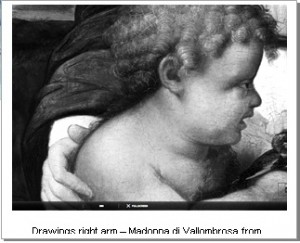 The last examination were done by the Lumiér´s Laboratories in Paris, who used the latest technical equipment with a combination of IR / X-ray called Multispectral analyse. The same method has, with exiting results, been used at Mona-Lisa in the Louvers, Paris and Lady with an Ermine, Leonardo’s Masterpiece in Krakow.
The last examination were done by the Lumiér´s Laboratories in Paris, who used the latest technical equipment with a combination of IR / X-ray called Multispectral analyse. The same method has, with exiting results, been used at Mona-Lisa in the Louvers, Paris and Lady with an Ermine, Leonardo’s Masterpiece in Krakow.
As a result of Lumiere´s work it is possible to see the underlying drawings. Made by an absolute master.
The project-name “Madonna di Vallombrosa” fit’s rather perfect since, among other experts, Måns Holst-Ekströms’s more than 2 years research/treatise gives evidence of the fact that the since nearly 200 year lost original Madonna-painting from the monastery of Vallombrosa, outside Firenze, is found. Among other evidence the Madonna is mentioned in the monastery’s inventory-list: “Uno Vergine in Tavola col bambino Jescé & S:Gio: Batt: di Raffaello d’ Urbino”.
Also Dr.Tatiana Kustodieva, former chief of the renessance pavilion at the Ermitage, St. Petersburg, says in her report that she will not reject the possibility that the painting is the real Vallombrosa-painting, as the painting fits perfect to “Gentili´s” description of the Madonna-painting in Vallombrosa.
In the continuation we will name the painting – Madonna di Vallombrosa.
The work has been set up in four different but co-operating headlines:
A. Arkeometric line.
Here is to find out if the painting has the physical and material quality as to be expected from a Renaissance-painting on a panel of wood. For these researches we have been in contact with conservators and scientists with special knowledge.
B. Estetic/art-scientistic line.
If the result under point A shows the right direction next question is: On which level will the painting be looking from estetic view? For this line well known professors from universities and museums, specialised on Renaissance-paintings, has been participating.
C. Provenience-line.
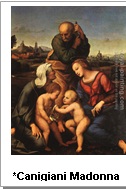 Since 1507 – when the two brothers of Milanese bought the painting as an altarpiece for the monastery of Vallom-brosa (most probably because the abbot was the third brother), the first version of the painting was given as a wedding gift to his best friend Lorenzo Nazi when he married the daughter of the patronage family – Canegiani * – the painting has had a quiet life in a perfect dark climate until the Napoleon troops invaded Firenze and the painting, located in the private villa of the abbot, were private handed over 1808 to the French general LaForreste.
Since 1507 – when the two brothers of Milanese bought the painting as an altarpiece for the monastery of Vallom-brosa (most probably because the abbot was the third brother), the first version of the painting was given as a wedding gift to his best friend Lorenzo Nazi when he married the daughter of the patronage family – Canegiani * – the painting has had a quiet life in a perfect dark climate until the Napoleon troops invaded Firenze and the painting, located in the private villa of the abbot, were private handed over 1808 to the French general LaForreste.
We have for this work been co-operating with Swedish scientists working in Italy and also people in France, England and Russia. The work is concentrated on the year from 1808 until now. Two independent tracks point to the, by Napoleon Bonaparte employed art expert, Marquees Laforreste who ”bought” the Madonna from the Monastery of Vallombrosa 1808.
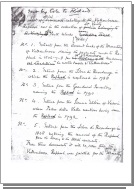 After restoration in Firenze 1835 by the famous restorer Giovanni Colzi de Cavalcante, a copy made on canvas was ordered by the Marquise LaForreste and executed by Mr. Caval-cante – the painting was sold to a Dr Verity as “Madonna di Vallombrosa” for a heavy sum of money (but the copy made on canvas were delivered).
After restoration in Firenze 1835 by the famous restorer Giovanni Colzi de Cavalcante, a copy made on canvas was ordered by the Marquise LaForreste and executed by Mr. Caval-cante – the painting was sold to a Dr Verity as “Madonna di Vallombrosa” for a heavy sum of money (but the copy made on canvas were delivered).
We have tracked this copy** to a monastery scool in Bath and also have been in contact with the family Verity whostill has correspondence and notes*** in the family archive from this period.
But what about the left restored painting? The tracks goes from Laforreste to the Russian nobleman Furst Anatole Demidoff (1812 – 1870), Prince of Donato.
D. Special research
A lot of side-lines has been created during the work. As for example to find out what´s written at the backside of the painting, partly scratched away. See Dr Scolaro´s investiga-tions. Or about the guide lines or compass lines Dr. Easthoug found at the X-ray pictures?
Or the perfect construction of the beneath holy triangle; Or the text written in mirror way
As in Da Vincys diarys; Or….
E. Legality
Juridical experts in Sweden and England has been involved to solve out the legal aspects of the Madonna. This as it is a minor possibility – in luck of the complete provenience during 1865 – 1989 that the painting is one of the more than 30.000 paintings, and a handful absolutely masterpieces, that disappeared during the World War 2, of which more than 12.000 not could be returned.
Search has been made in all archives with no result. No owner – no claims – nothing. Can be mentioned that the time of prescription for war-goods from World War 2 is 30 years – until 1976.
The Madonna has during the years 1991-2011 been examined and analysed by the following scientists, professors, museum-intendents and conservators.
A. ARKEOMETRIC EXAMINATION
Conserv.ma. Mats Lindskoug
Conservator with private laboratories in Lund, Sweden. Lindskoug has been head-conservator at the exhibition Da Vinci in Sweden, responsible for originalwork by Da Vinci.To his qualifications could be added the discovery of a former unknown Pieter Breugel the older.
Mats Lindskoug was the first professional scientist to study the Madonna in his laboratory July 1991. He writes in his report:
– ”an absolute magnificent Renaissance-painting… One of the best I have had the pleasure
to study”.
– ”I’m overpowered that the painting is in such a good condition. Probably because it has been in perfect climate and temperature the year around (c/a 17° C) without direct sunshine in the Monastery of Vallombrosa”.
– ”The strictly horizontal and vertical nailholes in the woodenpanel, the thickness and the tracks of worms points to the fact that the painting has been fixed to a frame probably an altar. The tracks of worms and the pink imprimatur that is partly hanging over the panel-edge shows the panel cannot have been trimmed after the original painting has been finished”.
– ”The painting has been restored, especially the blue in Maria´s dress, probably during first half of 1800”.
PhD. Göran Possnert
Professor at The Swedberg Laboratories, Uppsala University, Sweden
Possnert has made a C-14 test of the panel (poplar) in August 1991 to examine the age of the material in the panel. The C-14- method examine the radioactive intensity in the coalatom in the material.
Prof. Possnert is one of the leading in his field. To his more spectacular work can be added to examine the age of the Alpman found in the Alps of Switzerland.
The test of the Madonna’s panel gave the result 1465 ± 70 years, which shows the age of the wood 1465 +/- 70 year. This result gives that the panel, in two pieces from the same tree of poplar, has been cut and dried some years to fit the time for the painting of the Madonna the year of 1506/07.
PhD Bengt Skans/Prof. Claes Malmqvist
Arkeometriskt Forskningsinstitut, Hörby, Sweden
Dr Skans is specialised in analysing and fixing the material in older paintings according to paint/pigments, glue and other components. Dr. Skans together with Prof. Lindberg found an unknown painting by Cennino Cennini in Florence.
Conserning the Madonna Dr Skans established that the different paint levels, pigments of the imprimatur and that the painting partly had been painted with smalt. Smalt is cobaltglass which fine-crushed were in use since the Antic. Except in the Madonna Raphael has used smalt also in the CanigianiMadonna.
Also as a result of Dr Skans examination, he found out that the green leaves at the foot of Maria is painted with Malakit. Malakitgreen has not been used after the year of 1600.
Dr. Skans has been involved for more than 2 1/2 years. He has been away from the project the last year because of sickness. He is now at the end of the complete report of the pigments, and we hope he will be able to finishing it.
Dr. Skans has taken a lot of pigment samples and analyses has been done in SEM-EDX Microscope, Gascramatograph and final in the PIXE-proton-accelerator, at the University of Lund, under supervising of Prof. Claes Malmqvist.
Waiting for the final report, we knew that the result about the gesso ground, pink imprimatur and other pigment fits more than perfect comparing to similar tests of other Raphael paintings.
Thomas Petéus, Margareta Edebo
Studio of the Western Sweden Conservators Trust, Gothenburg, Sweden
Thomas Petéus is head conservator at the studio and works with examination, restoring etc. of collections belonging to the museums in Western part of Sweden.
At the studio special photos were taken by Margareta Edebo together with X-ray, UV-fluorescence and preliminary investigation with IR-camera and some pigment sample. The X-Ray photos were then later examined in England by Dr Eastaugh. See below.
PhD Nils Ångström
Dr Ångström is chief of The Swedish Police Forensic Laboratory, at the department for analyses and judgement of falsification in art.
A preliminary IR-examination in macro was done, were parts of the underlying drawing could be seen. Especially interesting is, that the Madonna’s head in the final painting has a perfect corrected form according to the underlying in IR visible drawings, compared to the inexact form of the Maria´s head in Madonna del Cardellino. The bridge has also been moved to the left deviating from the drawing.
The painting of The Madonna in most part that could bee seen, because of the thickness of the paint layer, follows the underlying drawing exact. A difference, comparing with Madonna del Cardellino, is that the children and also Mary has got a more slimmed form.
Comparing the both paintings in colour-slides shows that there could be no doubts that the same original-cartoon had been used for both of the paintings.
PhD Conservator Nicholas Eastaugh, London
Dr. Eastaugh is mostly well known in England as conservator with great experience in Renaissance paintings.
We got the recommendation to Dr Eastaugh by the conservatorstudio at the National Gallery as this studio will not investigate private paintings.
Dr Eastaugh has examined the painting with underlying drawings during a one week stay in London at the end of May 1994, using an IR-system connected to a sophisticated computer program. The main work was to examine in detail the X-ray photos and with the IR-system try to find as much as possible of the underlying drawings and pentimenti.
A very important discovery was, that Dr. Eastaugh revealed an underlying structure of four horizontal guidelines. The first line (87,7 cm from the bottom of the panel) seems to be a “varnishing point” for the background. The second line (63,6 cm from bottom) which, together with the presumed vertical line (fragments can be seen on X-Ray) exact in the middle of the panel, cut each other as a cross in the middle of the Madonna’s face.
The third line (53,1 cm) is exactly in the middle of the panel. The fourth horizontal line is 31,9 cm from the bottom. Compare the same guide-lines as can bee seen in X-Ray from the restoration of Raphael’s The Garavagh-Madonna
What is the function of the fourth line 31,9 cm from bottom of the panel?.
If using this horizontal line as a base for a triangle, which ends exactly in the fontanel of the head of Maria we will get a perfect triangle with equal sides. Probably evidence of how the discussed triangle composition in Raphael’s Madonna-paintings is constructed.
The wholy triangle
According to the pre-Renaissance invented mathematical rules, a triangle also were in religious use describing the world. Therefore the triangle were important especially in holy paintings.
Dr. Eastaugh has, after taken about 15 different pigment-samples, in middle of November 1994, finished a report about comparing the samples with results from other Raphael-paintings, using polarised light microscope for study the particle morphology.
See separate reports, together with IR- mosaic-pictures, of Dr. Eastaugh’s examination.
B. Estetic- art-science examinations
Prof. PhD Bo-Ossian Lindberg
Prof. Lindberg was former professor at The Institution of Art, Lunds University and is now professor and head of Institution of Art at Åbo University, Finland.
Prof. Lindberg has been involved in the examinations of the Madonna since 1992 and has, after nearly two years with several analyses of the painting and after visiting Uffizi, Florence, written a report comparing the Madonna with Madonna del Cardellino at the museum of Uffizi, Florence.
Signature
Among other things he is writing about the sensational discovery that the painting is signed by Raphael mirror way (in the same way as Da Vinci used in “secret” documents) in the Madonna’s prayer-book: “RAPHaello Da u.” or maybe “RAPHaello u.”
(Ed. note: The name is spelled and the picture fits with his signature the way he used in private: Raphaello dipintore. See copy of private letters to his onkel Simone Ciarla.
One qualified guess is, as traditionally in the contract orders that the master must paint the main figures, the well-hidden signature in the holy prairbook is to proof for the buyer Vallombrosa, if necessary, that he has done
the head parts although an assistant has done the background and finished the painting during R:s stay in Rome?
Most facts are pointing to, that this is the Madonna-painting according to Vasari, that Ridolfo Ghirlandaio finished when Raphael went to Rome!)
Prof. Lindberg ends his report:
-“The mechanical repetition of the background trees from the Uffizi version points to the hand of an assistant, but the best parts, such as the flesh and the foreground herbs, are of a superb quality, consistent with no lesser painter than Raphael himself. In my view the Gothenburg Madonna is an original work by Raphael of Urbino”.
PhD Intendent Tatyana Kustodieva
Dr Kustodieva is chiefintendent at the Department for Art of Renaissance, Ermitage, S:t Petersburg, Russia. Therefore responsible for several Raphael- and Da Vinci-paintings.
Dr. Kustodieva has at two occasions examined the Madonna. Between these occasions has she been in Florence for studies of Madonna del Cardellino in Uffizi to be sure of–*- her examination of the Madonna. From her report is to be read:
-”Other scientists has already made notes – and I will agree with them – the exactness in the volumes, softness in modelwork and the superb drawing.
-”I will not reject the possibility that the painting is the one from Vallombrosa, according to Gentili´s footnote to Vasari fits perfect to the Swedish Madonna, more of because Gentili is talking about both the paintings perfect condition and a crack between the two board of panel”.
-”A masterpiece with highest quality, the best replica* of Madonna del Cardellino, maybe the one from Vallombrosa.
(* The word replica in art-connection is that the same artist has made another original work – often better than the first one because the artist improves details/mistakes).
Prof. PhD Pierluigi de Vecchi
Former professor at the University of Milano, now headmaster and professor at the University of Macerata, Italy. Prof. de Vecci is to be seen as one of the most important experts of Raphael and has written important literature in his field.
During the summer in 1995 Prof. de Vecchi participated in a informal symposium in Gothenburg around the Madonna..
During the second day of the seminar, using only the normal daylight, examining the Madonna’s right hand and the right foot of Jesus, Prof. de Vecci said:
-” that there is no one else that can paint like that more then the master himself. Who else unknown master could it be!?”
-”there is to be seen typical adjustment for Raphael of the foot of Jesus, adjustment because of the difficult angle”.
Vi have got a first report from the symposium, written by Prof. de Vecchi, Prof. Emiliani and Prof. Scolaro together.
Superintent PhD Andrea Emiliani
Prof.Emiliano is superintent for all museums in Bologna and has examined deeply the Raphael painting S:ta Cecilia. This work has been published by Accademia-Raphaello in Urbino.
Prof. Emiliani´s reputation as an expert of Raphael-paintings is absolutely first class. He participated at the symposium in Gothenburg to study the Madonna and were convinced that:
– ”the Madonna could not be a copy or a falsification. It seems to be the lost original Vallombrosa-Madonna and because of the quality of the painting it is absolutely an original work “.
Prof. PhD. Michela Scolaro
Prof. Michela Scolaro teacher the University of Macerata. Prof. Scolaro has earlier working with research about art thefts in Toscany during the Napoleon-war.
Prof. Scolaro has been involved with research of the Madonna because her access to closed family archives in Florence.
By Prof. Scolaro planned further researches:
* Research in archives from the Milanese family.
Trying to find written evidence of the possibility, that the two brothers Milanese who ordered, paid (total 56 big florins1 in gold) and donated the Madonna-painting to Vallombro-sa, was because of that the third brother was at the time Abbott in the monastery of Vallombrosa and therefore was not able himself to use the Milanese family-fortune to order and pay for the painting. Some family-agreement or will could therefore has been written. If documents will be find, will the painting be described? No report. Future investigation.
* Research in archives from the family of Canigiani.
According to Vasari, Raphael “let make” a Madonna-painting to his friend Lorenzo Nasi who 1506 married Sandra from the important Florence-family di Matte Canigiani. Nothing says if the painting was a gift or from whom. As the Canigianis were patronage of Raphael (Domenico Canigiani ordered 1507 the painting “Holy Family with the Lamb) the “Madonna del Cardellino” could have been a wedding gift to Nasi’s from the family of Canigiani.
Other connection is, that Vallombrosa´s following abbot, elected 1515, was Giovanni Maria Canigiani. No report. Future investigation.
* Specified research about Pietro Perugino’s
Drawings, note- and register-books during the period of 1505-1508.
Perugino, well known as the artist of Vallombrosas head-altarpiece, the Assunta, (1500-1501) maybe get the order of the altar piece together with Raphael to the monastery’s new built chapel-room called “Capella di Madonna” (left of the old entrance) and therefore possible made drawings during his stay in Vallombrosa to describe and show the idea of the carpenter work of the altar. No report. Future investigation.
*Research in the same period to find notes from Ridolfo Ghirlandaio.
Maybe the Vallombrosa-Madonna is the Madonna-painting, referring to Vasari, that was finished by Ghirlandaio when Rafael was called to the pope in Rome?
No report. Future investigation.
Prof. Scolaro solved with her research, the partly illegible text on backside of the painting that “something happened in Florence 1835”.
Giovanni Colzi-Cavalcanti (scratched) 1835
With most possibility the text is written by the well known art-conservator G. Colzi-Cavalcanti, who in Florence the year of 1835 has cleaned and repainted partly the Madonna.
Also Prof. Scolaro participated in the Gothenburg- symposium and have pointed out her apprehension of the Madonna as an original work by Raphael:
-”the painting has been executed under his (Raphael’s) directly control and with co-operation”
-”as the Madonna fore sure can be identified as the Vallombrosa-painting”.
Prof. PhD Antonio Paolucci, Florence, Italy
Through Prof. Emiliano audience has been arranged for. Prof. Scolaro to Prof. Paulucci, who is the former culture minister in Italy and superintendent of all art and historic museums in Tuscany (incl. Uffizi)
As Paulucci “were highly impressed of the presented material and the superb quality of the painting. He has arranged with “the keys” to locked archives in Uffizi for Prof. Scolaro´s research.
Prof. Paulucci is very interested to arrange bringing the painting to Uffizi, Florence with all necessarily guarantees from the Italian Government.
Prof. Aleessandro Vezzosi
Prof. Vezzosi is a specialist on Italian Resents-art, especially Da Vinci´s works and is the founder of the Da Vinci-museum in Vinci.
Vezzosi were send by the Italian Government to take responsible and authorise the Da Vinci´s “Codex Hammer” when sold to Bill Gates, USA.
Prof. Vezzosi were invited to examine the painting end of 1995 in Gothenburg. He is convinced that the painting is the original Vallombrosa-Madonna and also that the new-found signature in prayer-book is authentic and typical for Raphael’s influence from Da Vinci. No report is written.
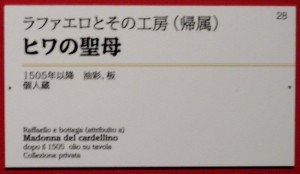 Prof. Vezzosi has been involved as an artistic Director in the exhibition “Leonardo da Vinci and his idea of beauty”, shown at three museums in Japan 2011 – 2012. Ending in Tokyo 1st of March – 10th of June. Madonna di Vallombrosa were invited to participate and got a honourable place alone on a Firenze red wall provided with a golden frame with security glass.
Prof. Vezzosi has been involved as an artistic Director in the exhibition “Leonardo da Vinci and his idea of beauty”, shown at three museums in Japan 2011 – 2012. Ending in Tokyo 1st of March – 10th of June. Madonna di Vallombrosa were invited to participate and got a honourable place alone on a Firenze red wall provided with a golden frame with security glass.
After several discussions about the paintings project name “Madonna di Vallombrosa” the exhibition committee decided to use the same name as the famous “sister painting in in Uffizi, Florens”:
Raffaello a bottega. (Attribuita a)
– Madonna del Cardellino –
Collecione privata
The exhibition were a success, seen by nearly 220 000 persons. In Tokyo most of the noble art society were invited together with both TV, press and the ministry of culture.
The transportation cask follows museum standard with security people taking care of the special transport and before the delivery “home” in Schweitz (wall to wall) our curator together with people from insurance company will check the condition of the painting.
Prof. PhD. Eliseo Fava
Prof. Fava, former professor at the institution of art-communication University of Bologna. He has organised several exhibitions around the theme Art of Italian Renessans. Most attentions gives the exhibition of Da Vinci – for now in the United States.
Prof. Fava has, during the time, been very helpful with very interesting ideas and contacts, such as arranging end of 1993 an afternoon scientist meeting in Lund, Sweden around the painting, to which were invited:
Prof. Tatiana Kustodieva, S:t Petersburg, Russia
Prof. Janus Valusz, Krakow, Poland
the former ministry of Culture in Poland and other specialists.
The meeting were hold without any assumptions as technical reports etc. – just some hours with the painting. The one opinion was that this masterpiece must have been painted in Florence, in the same time and same workshop as the Uffizi-Madonna, and probably using the same cartoon.
Prof. Fava had also knowledge against the doubts from Cavalcaselle about Jacopo Cavalucci’s report that the accounts/documents, stored in Archivo di Stato, Florence, mean Rafaellino del Garbo instead of Raffaello:
./. At first the price is wrong. To high for a Raffaellino.
./. Second, that the period between the payments is because Raphael during that
time was in Rome.
./. And Third, Rafaellino’s painting, with the abbot S. Giovanni Gualberto is sit-
ting in the middle, cannot be the “Tavola del altare della Chiesa Vallombrosa”
that means in the accounts from Vallombrosa in Jan. 1506.
Afterwards Måns Holst-Ekström has found evidence that the Rafaellino-painting was ordered with it’s specific measurements between two specific pillars in the church of Vallombrosa.
Symposiums
In April 1993 a first symposium was held at the Swedish Institute in Rome, Italy were Måns Holst-Ekström and Prof. Bo-Ossian Lindberg for the first time, together with invited scientist, had a “round-table-discussion” around their investigations of the painting.
As mentioned, in middle of 1995 a private symposium around the painting was arranged in Gothenburg with Prof. Bo-Ossian Lindberg as chairman together with Prof. Eliseo Fava, Prof. Andrea Emiliano, Prof. Michela Scolaro, Prof. Pierluigi de Vecchi, Dr. Nicholas Eastaugh, Dr. Mats Lindskoug and others, to co-ordinate and solve out reports and discoveries.
C. Provenience
Dr.Fil.Lic. Måns Holst-Ekström
Holst-Ekström was active at The Swedish Institute in Rome 1993-94 . During this time he was commissioned to closer examine the at that time very actual trace of the Madonna that lead to the convent of Vallombrosa.
This examination resulted in an graduating work which in a convincing way shows that the painting is the Madonna-painting that was commissioned by the convent of Vallombrosa through founds from the family Milanese, two brothers to the abbot at that time.
The guide of Holst-Ekström at the work with the essay was Prof. Sten-Åke Nilsson, Lund, Sweden.
Se separate printed work by Måns Holst-Ekström
Present provenience investigation
From the convent of Vallombrosa the trace goes on to the Marquees Laforreste who at the time of the wars of Napoleon in Italy, had the knowledge and special function to supply the newly built wing of the Museum of Louvres in Paris, with high class masterpieces from among others Italy and Spain.
The Marquees Laforreste lead the pillage of the convent of Vallombrosa in the year 1808, during which all of the valuable art of the convent was taken to the prefecture in Florence. Nevertheless the Madonna is not among the list of the Prefecture according to research made in Archivo di Stato, Florence.
Laforreste probably bought the Madonna for his own use. The picture was likely kept in the private villa of the abbot in the mountains just above the convent. As the acquirement was in opposition to the instructions of Napoleon, there had to be the utmost discretion. For this reason, there is of course is no documentation of the transaction in the archives of the convent of Vallombrosa.
The obvious connection to the marquees is shown by the fact that his widow sold the Vallombrosa-madonna 1837 to the wealthy doctor Verity. As a certificate of the genuineness that proved the picture to have been painted by Raphael, it is said that purchase-documents from the convent of Vallombrosa was accompanying the picture.
The purchase of Dr. Verity is much later proved to be an antique-looking old copy on canvas . That the widow made the transaction could have been an attempt to create an alibi for the marquees, if the falseness would have been discovered, because the marquees passed away much later.
Contacts has been made with the Victoria & Albert Museum in England where the Verity-copy were kept. As said before, contacts has been taken with the late Verity family who has kept documents and notes from the period.
It is very likely that it is marquees Laforreste, who in 1835 is having the Madonna restored by the most wellknown conservator in Florence, Giovanni Colzi de Cavalcanti. (See the research concerning the text on the backside of the Madonna. by Prof. Scolaro).
Marquees Laforreste has surely given the commission to Cavalcanti to do a copy, which according to the rules was made in a different size ( bigger!) in comparison with the original Madonna. The copy was suitably employed in the Verity-affair year 1837.
Present research shows the possibility that Laforreste sold the Madonna discreetly about year 1840 to the Russian nobleman Anatole Nicolajevic Demidoff (later prince of San Donato) who purchases the Madonna shortly before his marriage to Mathilde Bonaparte (Princess of Westfahlen).
As this sale had to be with biggest discretion (the painting were already sold to Dr Verity) there are nothing written that can give light to this transaction. Or to the relatives. The family of Demidoff cease to exist and the lines points to that the nepot Ivanovic sells the Madonna together with the rest of the family-arts in Villa Donato, Florence latest the year of 1880. This sale is probably to finance the refurbishing of Villa Pratolino, Florence.
As no contracts or any notes has been found – the new coming ages for the painting after 1865 became to just “ be a copy of the famous Madonna del Cardellino”. Also as a mediocre copy painted on canvas were found in the basement at the Monastery of Vallombrosa. Now in the archive of Uffizi. We have checked the painting. It´s really a mediocre painting. Probably executed by a monk (copy of the Madonna?) It was a shame having this painting as a replacement during the eight years of the original paintings restoration.
Search has been made in all archives and bigger museums in Europe with no result. No owner – no claims – nothing. As one voice said – who is looking for a copy of this famous painting?
(among at least 400 more or less well done copies)
Can be mentioned that the time of prescription for war-goods from World War 2 is 30 years – until 1976
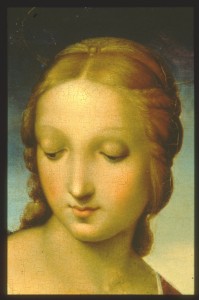

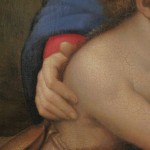

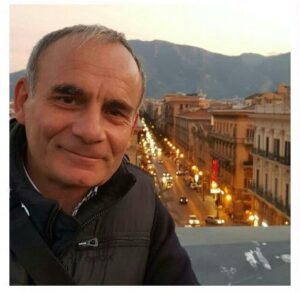





ma sei……. ^_^
buon giorno a tutti io cio’un quadro cosi non so se originale ma dietro ce’ sritto (raffaello sanzio uffici di firenze oro n.2634)ma quanto vale era di una mia vecchia zia morta e io lo stavo buttanto.
Si tratta di una copia numerata. Per quanto riguarda il valore, posso solo consigliarle di farla vedere a un antiquario.
Cordialmente
Gian J. Morici